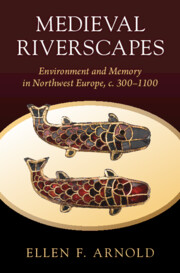Book contents
- Medieval Riverscapes
- Studies in Environment and History
- Medieval Riverscapes
- Copyright page
- Dedication
- Contents
- Figures
- Maps
- Tables
- Acknowledgements
- Preface
- Introduction
- 200–450: Late Antique Gaul
- 1 Poetries of Place
- 450–750: The Merovingians
- 2 Rivers of Risk
- 3 River Resources
- 750–950: The Carolingians
- 4 Rivers and Memory
- 950–1050: The Year 1000 Question
- 5 Ruptured Rivers
- 6 Meanderings
- 1050–1250: A New World?
- 7 The Same River Twice
- Bibliography
- Index
- Studies in Environment and History
2 - Rivers of Risk
Published online by Cambridge University Press: 15 March 2024
- Medieval Riverscapes
- Studies in Environment and History
- Medieval Riverscapes
- Copyright page
- Dedication
- Contents
- Figures
- Maps
- Tables
- Acknowledgements
- Preface
- Introduction
- 200–450: Late Antique Gaul
- 1 Poetries of Place
- 450–750: The Merovingians
- 2 Rivers of Risk
- 3 River Resources
- 750–950: The Carolingians
- 4 Rivers and Memory
- 950–1050: The Year 1000 Question
- 5 Ruptured Rivers
- 6 Meanderings
- 1050–1250: A New World?
- 7 The Same River Twice
- Bibliography
- Index
- Studies in Environment and History
Summary
This chapter explores the ways that rivers could shift from cultural and economic resource to sites of risk. Beginning with a close reading of the early medieval historian Gregory of Tours, it argues that as a bishop, Gregory saw rivers both as sites of regular and significant economic and cultural risk and of potential religious salvation. This balance between practical and religious response and representation weaves through the chapter, which draws heavily on hagiographical accounts and historical sources to explore cultural constructions of “risk.” Rivers were sources of economic and political instability, and threats to cultural memory and cohesion. Floods, shipwrecks, drought, and other disasters are found throughout medieval narrative, and form the basis of this chapter’s analysis. Finally, this chapter argues that medieval authors also saw rivers as connected to existential threats: the “Flood,” sin, demons, and the dissolution of memory and cultural identity. Paired with these fears, those same rivers became sources of salvation and markers of sanctity.
- Type
- Chapter
- Information
- Medieval RiverscapesEnvironment and Memory in Northwest Europe, c. 300–1100, pp. 69 - 102Publisher: Cambridge University PressPrint publication year: 2024

